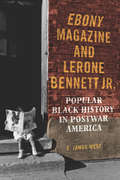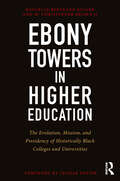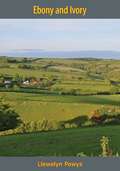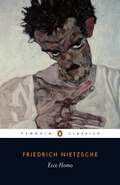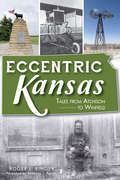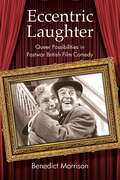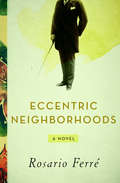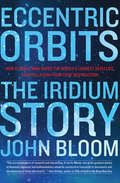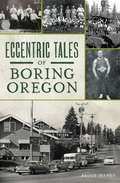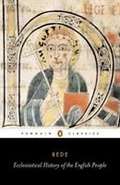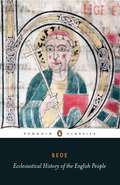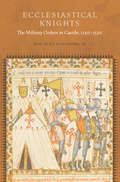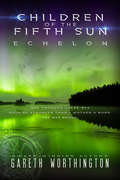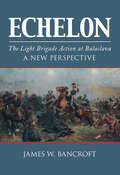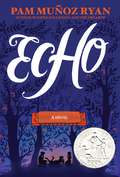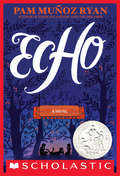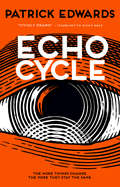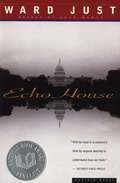- Table View
- List View
Ebony & Scarlet: Poems of the Anglo-Zulu War
by Harry TurnerThe nineteenth century saw the British army engaged in a series of conflicts around the globe. Iin almost every continent the redcoats of British soldiers seemed to be in perpetual action against enemies of the Crown. The Anglo-Zulu War, fought in southern Africa in 1879, was one of the bloodiest of these conflicts, and one of the most famous, and it has fascinated historians ever since. But the story has never, until now, been re-told in verse and that is what Harry Turner does in the sequence of poems he has composed for this memorable volume. He concentrates on the relationship between the British and the Zulus, on the politics and ambition that gave rise to the war and on the series of bloody battles that followed in particular at Isandlwana, Rorke's Drift and Ulundi. Graphically he recalls how King Cetshwayo's Zulu warriors, armed mainly with spears, gave the British a mauling before they were finally overcome. The story has often been told before, but rarely in such an original and evocative way. Harry Turner's work will be an absorbing introduction to the subject for readers who are coming to it for the first time, and it will add a new dimension to the understanding of readers who are familiar with the many more conventional histories of the conflict.
Ebony Magazine and Lerone Bennett Jr.: Popular Black History in Postwar America
by E. James WestFrom its launch in 1945, Ebony magazine was politically and socially influential. However, the magazine also played an important role in educating millions of African Americans about their past. Guided by the pen of Lerone Bennett Jr., the magazine’s senior editor and in-house historian, Ebony became a key voice in the popular black history revival that flourished after World War II. Its content helped push representations of the African American past from the margins to the center of the nation’s cultural and political imagination. E. James West's fresh and fascinating exploration of Ebony’s political, social, and historical content illuminates the intellectual role of the iconic magazine and its contribution to African American scholarship. He also uncovers a paradox. Though Ebony provided Bennett with space to promote a militant reading of black history and protest, the magazine’s status as a consumer publication helped to mediate its representation of African American identity in both past and present. Mixing biography, cultural history, and popular memory, West restores Ebony and Bennett to their rightful place in African American intellectual, commercial, and political history.
Ebony Towers in Higher Education: The Evolution, Mission, and Presidency of Historically Black Colleges and Universities
by Ronyelle Bertrand Ricard M. Christopher Brown IIWhat is the purpose of black colleges? Why do black colleges continue to exist? Are black colleges necessary?Historically Black colleges and universities (HBCUs) are at the same time the least studied and the least understood institutions of higher education and the most maligned and the most endangered.This unique study examines the mission of four-year HBCUs from the perspective of the campus president, as a foundation for understanding the relevance and role of these institutions. This is the first research to focus on the role of presidents of black colleges; is based on extensive interviews with fifteen presidents; and takes into particular account the type of campus environments in which they operate.Unlike community colleges, women’s colleges, men’s colleges, and Hispanic-serving colleges, Black colleges are racially identifiable institutions. They also vary significantly in, among other characteristics: size, control (public or private), religious affiliation, gender composition, and available resources. Although united in the historic mission of educating African Americans, each black college or university has its own identity and set of educational objectives. The book examines how presidents define and implement mission in the context of their campuses, view the challenges they face, and confront the factors that promote or hinder implementation of their missions.
Ebony and Ivory
by Llewelyn Powys Edward ShanksFirst published in 1923, this book is a wonderful collection of short stories and sketches from the British novelist Llewelyn Powys—who also happens to be the younger brother of John Cowper Powys, another renowned British novelist of the twentieth century.“When Llewelyn Powys puts pen to paper, something miraculous happens with words. And that’s literature.”—New York Herald Tribune“This writer has a great gift of saying the essential thing in a few words. Not one of these essays extends beyond half-a-dozen pages yet how full of good matter they are.”—C. K. Shorter“Llewelyn Powys is a poet in the loving, absorbing, indwelling quality of his experience.”—Basil de Selincourt
Ebony and Ivy: Race, Slavery, and the Troubled History of America's Universities
by Craig Steven WilderA 2006 report commissioned by Brown University revealed that institution's complex and contested involvement in slavery--setting off a controversy that leapt from the ivory tower to make headlines across the country. But Brown's troubling past was far from unique. In Ebony and Ivy, Craig Steven Wilder, a rising star in the profession of history, lays bare uncomfortable truths about race, slavery, and the American academy. <P><P> Many of America's revered colleges and universities--from Harvard, Yale, and Princeton to Rutgers, Williams College, and UNC--were soaked in the sweat, the tears, and sometimes the blood of people of color. Slavery funded colleges, built campuses, and paid the wages of professors. Enslaved Americans waited on faculty and students; academic leaders aggressively courted the support of slave owners and slave traders. Significantly, as Wilder shows, our leading universities, dependent on human bondage, became breeding grounds for the racist ideas that sustained them. Ebony and Ivy is a powerful and propulsive study and the first of its kind, revealing a history of oppression behind the institutions usually considered the cradle of liberal politics.
Ecce Homo: How One Becomes What One is
by Friedrich NietzscheIn late 1888, only weeks before his final collapse into madness, Nietzsche (1844-1900) set out to compose his autobiography, and Ecce Homo remains one of the most intriguing yet bizarre examples of the genre ever written. In this extraordinary work Nietzsche traces his life, work and development as a philosopher, examines the heroes he has identified with, struggled against and then overcome - Schopenhauer, Wagner, Socrates, Christ - and predicts the cataclysmic impact of his 'forthcoming revelation of all values'. Both self-celebrating and self-mocking, penetrating and strange, Ecce Homo gives the final, definitive expression to Nietzsche's main beliefs and is in every way his last testament.
Ecce Humanitas: Beholding the Pain of Humanity (Insurrections: Critical Studies in Religion, Politics, and Culture)
by Brad EvansThe very idea of humanity seems to be in crisis. Born in the ashes of devastation after the slaughter of millions, the liberal conception of humanity imagined a suffering victim in need of salvation. Today, this figure appears less and less capable of galvanizing the political imagination. But without it, how are we to respond to the inhumane violence that overwhelms our political and philosophical registers? How can we make sense of the violence that was carried out in the name of humanism? And how can we develop more ethical relations without becoming parasitic on the pain of others?Through a critical exploration of violence and the sacred, Ecce Humanitas recasts the fall of liberal humanism. Brad Evans offers a rich analysis of the changing nature of sacrificial violence, from its theological origins to the exhaustion of the victim in the contemporary world. He critiques the aestheticization that turns victims into sacred objects, sacrificial figures that demand response, perpetuating a cycle of violence that is seen as natural and inevitable. In novel readings of classic and contemporary works, Evans traces the sacralization of violence as well as art’s potential to incite resistance. Countering the continued annihilation of life, Ecce Humanitas calls for liberating the political imagination from the scene of sacrifice. A new aesthetics provides a form of transgressive witnessing that challenges the ubiquity of violence and allows us to go beyond humanism to imagine a truly liberated humanity.
Ecce homo
by Friedrich NietzscheEcce homo. Cómo se llega a ser lo que se es, resulta, sin duda alguna, el título más pertinente para la autobiografía del genial filósofo y pensador alemán Friedrich Nietzsche. Ecce homo, o "Aquí tienen al hombre", son las palabras con que Pilatos entrega a Jesucristo a la crucifixión, sin encontrar culpa en él, pero también sin poder torcer su destino, Ecce homo, así se autodefine el propio Nietzsche. "Cómo se llega a ser lo que se es" es simplemente el legado de alguien que supo asumir su propio destino, que supo estar a la altura de él y encarnarlo. Ecce homo se publicó en 1908, veinte años después de su redacción en 1888, y ocho después de la muerte del autor. En 1888 Nietzsche siente que no le queda mucho tiempo y, el 15 de octubre de ese año, el día que cumplía 44 años, decide "contarse su vida a sí mismo"; desde ese día, hasta mediados de noviembre, trabajará intensamente en esta peculiarísima autobiografía.
Eccentric Kansas: Tales from Atchison to Winfield
by Roger L. RingerKansas has tales as extraordinary as its plains, although the stories behind the legends are sometimes lost to time. Discover the history of the state's world-class violinist, homemade airplane and alleged volcano. Iola's Mad Bomber blew up the town's saloons after a hangover. The bulletproof and most "extinctest" creature lurked in sinkholes outside Inman. Hunters in Stafford County learned to leave out enormous quantities of food for local hermit Pelican Pete. Join author Roger Ringer as he delves into these and other facts behind the myths of the Sunflower State.
Eccentric Laughter: Queer Possibilities in Postwar British Film Comedy (SUNY series, Horizons of Cinema)
by Benedict MorrisonEccentric Laughter explores new ways to watch postwar British film comedies, arguing that their representations of eccentricity offered a set of possible queer futures for a Britain that had been destabilized by years of conflict and social upheaval. Far from being the apolitical cinema described by previous critics, these comedies—including both perennial favorites from Ealing Studios and neglected films ripe for rediscovery—make a joke of and suggest alternatives to the heterocentric home and family. Referencing a wide range of theories, the book gives details of how these films' comic queernesses are not structured on fixed identities but on an open play of possibilities, depicting eccentricity, artifice, drag, ruins, and the wild in ways that can still offer inspiration for experiments in living today. Engaging with contemporary queer theories and politics, the book argues that these films continue to address questions of urgent relevance to students and other viewers in the twenty-first century. Films discussed include The Belles of St. Trinian's, Genevieve, The Lavender Hill Mob, Simon and Laura, The Stranger Left No Card, and Young Wives' Tale.
Eccentric Neighborhoods: A Novel
by Rosario FerréA &“colorful family saga&” set against the dramatic historical backdrop of twentieth-century Puerto Rico, from an author nominated for the National Book Award (Kirkus Reviews). Elvira Vernet narrates Eccentric Neighborhoods as she attempts to solve the mystery of who her parents truly are. Her mother, the beautiful and aristocratic Clarissa Rivas de Santillana, was born into a rarefied world of privilege, one of five daughters on the family&’s sugar plantation. Elvira&’s father, Aurelio Vernet, and his three brothers and two sisters were raised by Santiago, a Cuban immigrant who ruled his family with an iron hand. As Puerto Rico struggles for independence—and Aurelio takes his place among the powerful political gentry—a legacy of violence, infidelity, faith, and sacrifice is born. Set against the backdrop of a country coming of age, Eccentric Neighborhoods is a lush, transcendent novel, a family saga about mothers and daughters, husbands and wives, parents and children. In this magnificent follow-up to The House on the Lagoon, Rosario Ferré delivers a work of historical fiction influenced by magical realism and infused with forgiveness and love.
Eccentric Orbits: The Iridium Story
by John Bloom“In the early 1990s, Motorola, the legendary American technology company developed a revolutionary satellite system called Iridium that promised to be its crowning achievement. Light years ahead of anything previously put into space, and built on technology developed for Ronald Reagan’s “Star Wars,” Iridium’s constellation of 66 satellites in polar orbit meant that no matter where you were on Earth, at least one satellite was always overhead, and you could call Tibet from Fiji without a delay and without your call ever touching a wire. ridium the satellite system was a mind-boggling technical accomplishment, surely the future of communication. The only problem was that Iridium the company was a commercial disaster. Only months after launching service, it was $11 billion in debt, burning through $100 million a month and crippled by baroque rate plans and agreements that forced calls through Moscow, Beijing, Fucino, Italy, and elsewhere. Bankruptcy was inevitable—the largest to that point in American history. And when no real buyers seemed to materialize, it looked like Iridium would go down as just a “science experiment.” That is, until Dan Colussy got a wild idea. Colussy, a former head of Pan-Am now retired and working on his golf game in Palm Beach, heard about Motorola’s plans to “de-orbit” the system and decided he would buy Iridium and somehow turn around one of the biggest blunders in the history of business. In “Eccentric Orbits”, John Bloom masterfully traces the conception, development, and launching of Iridium and Colussy’s tireless efforts to stop it from being destroyed, from meetings with his motley investor group, to the Clinton White House, to the Pentagon, to the hunt for customers in special ops, shipping, aviation, mining, search and rescue—anyone who would need a durable phone at the end of the Earth. Impeccably researched and wonderfully told, “Eccentric Orbits” is a rollicking, unforgettable tale of technological achievement, business failure, the military-industrial complex, and one of the greatest deals of all time.
Eccentric Tales of Boring, Oregon
by Bruce HaneyThe town of Boring has seen more than its fair share of interesting events since its founding in 1903. From secretly hiring an up-and-coming boxer to fight the town bully to the time firecrackers were blamed for burning down half the town, memorable moments abound. Discover the story of the wild man who lived in the woods and the attempts of Prohibition-era moonshiners to evade the law. Uncover the true identity of the Wild West Gang and the real story of a runaway train loaded with potatoes. Join author Bruce Haney as he explores the peculiar tales of an exciting town.
Ecclesiastical History Of The English People (Forsyte chronicles)
by D. Farmer Leo Sherley-Price D. H. Farmer Saint Bede Ronald E. Latham David DumvilleThe Ecclesiastical History of the English People (731 AD) is Bede's most famous work. As well as providing the authoritative Colgrave translation of the Ecclesiastical History, this edition includes a new translation of the Greater Chronicle, in which Bede examines the Roman Empire and contemporary Europe. His Letter to Egbert gives his final reflections on the English Church just before his death, and all three texts here are further illuminated by a detailed introduction and explanatory notes. ABOUT THE SERIES: For over 100 years Oxford World's Classics has made available the widest range of literature from around the globe. Each affordable volume reflects Oxford's commitment to scholarship, providing the most accurate text plus a wealth of other valuable features, including expert introductions by leading authorities, helpful notes to clarify the text, up-to-date bibliographies for further study, and much more.
Ecclesiastical History of the English People: With Bede's Letter to Egbert and Cuthbert's Letter on the Death of Bede
by BedeWritten in AD 731, Bede's work opens with a background sketch of Roman Britain's geography and history. It goes on to tell of the kings and bishops, monks and nuns who helped to develop Anglo-Saxon government and religion during the crucial formative years of the English people. Leo Sherley-Price's translation brings us an accurate and readable version, in modern English, of a unique historical document. This edition now includes Bede's Letter to Egbert concerning pastoral care in early Anglo-Saxon England, at the heart of which lay Bede's denunciation of the false monasteries; and The Death of Bede, an admirable eye-witness account by Cuthbert, monk and later Abbot of Jarrow, both translated by D. H. Farmer.
Ecclesiastical Knights: The Military Orders in Castile, 1150-1330 (Fordham Series in Medieval Studies)
by Sam Zeno Conedera“Warrior monks”—the misnomer for the Iberian military orders that emerged on the frontiers of Europe in the twelfth century—have long fascinated general readers and professional historians alike. Proposing “ecclesiastical knights” as a more accurate name and conceptual model—warriors animated by ideals and spiritual currents endorsed by the church hierarchy—author Sam Zeno Conedera presents a groundbreaking study of how these orders brought the seemingly incongruous combination of monastic devotion and the practice of warfare into a single way of life.Providing a detailed study of the military-religious vocation as it was lived out in the Orders of Santiago, Calatrava, and Alcantara in Leon-Castile during the first century, Ecclesiastical Knights provides a valuable window into medieval Iberia. Filling a gap in the historiography of the medieval military orders, Conedera defines, categorizes, and explains these orders, from their foundations until their spiritual decline in the early fourteenth century, arguing that that the best way to understand their spirituality is as a particular kind of consecrated knighthood.Because these Iberian military orders were belligerents in the Reconquest, Ecclesiastical Knights informs important discussions about the relations between Western Christianity and Islam in the Middle Ages. Conedera examines how the military orders fit into the religious landscape of medieval Europe through the prism of knighthood, and how their unique conceptual character informed the orders and spiritual self-perception.The religious observances of all three orders were remarkably alike, except that the Cistercian-affiliated orders were more demanding and their members could not marry. Santiago, Calatrava, and Alcantara shared the same essential mission and purpose: the defense and expansion of Christendom understood as an act of charity, expressed primarily through fighting and secondarily through the care of the sick and the ransoming of captives. Their prayers were simple and their penances were aimed at knightly vices and the preservation of military discipline. Above all, the orders valued obedience. They never drank from the deep wellsprings of monasticism, nor were they ever meant to.Offering an entirely fresh perspective on two difficult and closely related problems concerning the military orders—namely, definition and spirituality—author Sam Zeno Conedera illuminates the religious life of the orders, previously eclipsed by their military activities.
Ecclesiastical Law, Clergy and Laity: A History of Legal Discipline and the Anglican Church (Law and Religion)
by Neil PattersonDiscipline in an ecclesiastical context can be defined as the power of a church to maintain order among its members on issues of morals or doctrine. This book presents a scholarly engagement with the way in which legal discipline has evolved within the Church of England since 1688. It explores how the Church of England, unusually among Christian churches, has come to be without means of effective legal discipline in matters of controversy, whether liturgical, doctrinal, or moral. The author excludes matters of blatant scandal to focus on issues where discipline has been attempted in controversial matters, focussing on particular cases. The book makes connections between law, the state of the Church, and the underlying theology of justice and freedom. At a time when doctrinal controversy is widespread across all Christian traditions, it is argued that the Church of England has an inheritance here in need of cherishing and sharing with the universal Church. The book will be a valuable resource for academics and researchers in the areas of law and religion, and ecclesiastical history. .
Ecclesiastical Lordship, Seigneurial Power and the Commercialization of Milling in Medieval England
by Adam LucasThis is the first detailed study of the role of the Church in the commercialization of milling in medieval England. Focusing on the period from the late eleventh to the mid sixteenth centuries, it examines the estate management practices of more than thirty English religious houses founded by the Benedictines, Cistercians, Augustinians and other minor orders, with an emphasis on the role played by mills and milling in the establishment and development of a range of different sized episcopal and conventual foundations. Contrary to the views espoused by a number of prominent historians of technology since the 1930s, the book demonstrates that patterns of mill acquisition, innovation and exploitation were shaped not only by the size, wealth and distribution of a house’s estates, but also by environmental and demographic factors, changing cultural attitudes and legal conventions, prevailing and emergent technical traditions, the personal relations of a house with its patrons, tenants, servants and neighbours, and the entrepreneurial and administrative flair of bishops, abbots, priors and other ecclesiastical officials.
Echelon (Children of the Fifth Sun)
by Gareth WorthingtonShe thought there was nothing stronger than a mother’s bond. She was wrong.FIFTEEN THOUSAND YEARS AGO, the knowledge bringers—an amphibious, non-humanoid species known as the Huahuqui—came after a great global flood, gifting humans with math, science, and civility.We killed them all.Seventy years ago, we found one of their corpses preserved in ice and eventually created a clone named K’in. Our governments fought over the creature and we killed it, too. Now, a sinkhole in Siberia has opened, revealing new secrets.FREYA NILSSON spent the last five years trying to forget her role in the Huahuqui cloning program. She hid her son, KJ, from the regimes and agencies she believed would exploit him for the powers he acquired through his father’s bond with K’in.An innocent trip to help KJ understand his abilities results in the conspiracy she fought to bury exploding back to life. Chased by new foes and hounded to put the world first, all Freya can think of is protecting KJ—at all costs.Children of the Fifth Sun: Echelon is the sequel to Gareth Worthington’s multi-award-winning debut novel Children of the Fifth Sun.
Echelon: The Light Brigade Action at Balaclava - A New Perspective
by James W BancroftLord Cardigan’s cavalry charge on 25 October 1854 at the battle of Balaclava ‘into the valley of death’ is surely one of the most famous actions in military history. Is there anything new to say about it in print? Yes there is, because most publications have concentrated on commanding officers Lucan, Cardigan and the fatal actions of Nolan. But there were 670 men in the charge and by collating the evidence from the many eyewitnesses James Bancroft offers a new and more accurate appraisal of events. Cardigan’s description of the action was quoted at length in the House of Commons: ‘… with the batteries vomiting forth upon us shells and shot, round and grape, with one battery on our right flank and another on the left … when we came to within a distance of fifty yards from the mouths of the artillery which had been hurling destruction upon us, we were, in fact, surrounded and encircled by a blaze of fire.’ One question of course – which the author, who has been studying the subject for many years, addresses – is how anyone survived.
Echi di una canzone: Un racconto de L'Eredità della Maschera (Legacy of the Mask Series #1)
by A L ButcherUna tumultuosa dozzina di anni dopo i drammatici eventi del Teatro dell'Opera di Parigi, Raoul, Conte di Chagny, è ancora tormentato dal misterioso Fantasma dell'Opera - la creatura leggendaria che aveva in pugno il personale del Teatro, rapito l'amante di Raoul e ucciso suo fratello. Nell'immaginazione turbata di Raoul, i fantasmi del passato sono ovunque, e la musica strana e potente lo chiama ancora nei suoi sogni. Follia, ossessione e l'eredità del passato tessono il loro incantesimo in questa storia breve e tragica basata sul Fantasma dell'Opera. Miglior fantasy 2019 su NN Light Book Heaven!
Echo
by Pam Muñoz RyanMusic, magic, and a real-life miracle meld in this genre-defying masterpiece from storytelling maestro Pam Muñoz Ryan. Lost and alone in a forbidden forest, Otto meets three mysterious sisters and suddenly finds himself entwined in a puzzling quest involving a prophecy, a promise, and a harmonica. Decades later, Friedrich in Germany, Mike in Pennsylvania, and Ivy in California each, in turn, become interwoven when the very same harmonica lands in their lives. All the children face daunting challenges: rescuing a father, protecting a brother, holding a family together. And ultimately, pulled by the invisible thread of destiny, their suspenseful solo stories converge in an orchestral crescendo. Richly imagined and masterfully crafted, ECHO pushes the boundaries of genre and form, and shows us what is possible in how we tell stories. The result is an impassioned, uplifting, and virtuosic tour de force that will resound in your heart long after the last note has been struck.<P><P> Winner of Newbery Honor
Echo
by Pam Muñoz Ryan2016 Newbery Honor BookNew York Times BestsellerAn impassioned, uplifting, and virtuosic tour de force from a treasured storyteller!Lost and alone in a forbidden forest, Otto meets three mysterious sisters and suddenly finds himself entwined in a puzzling quest involving a prophecy, a promise, and a harmonica. Decades later, Friedrich in Germany, Mike in Pennsylvania, and Ivy in California each, in turn, become interwoven when the very same harmonica lands in their lives. All the children face daunting challenges: rescuing a father, protecting a brother, holding a family together. And ultimately, pulled by the invisible thread of destiny, their suspenseful solo stories converge in an orchestral crescendo. Richly imagined and masterfully crafted, Echo pushes the boundaries of genre, form, and storytelling innovation to create a wholly original novel that will resound in your heart long after the last note has been struck.
Echo Cycle
by Patrick EdwardsGladiator meets 1984 in this near-future thriller featuring timeslips, ancient magic and a disturbingly plausible dystopian Britain...68 CEFleeing disaster, young Winston Monk wakes to find himself trapped in the past, imprisoned by the mad Emperor Nero. The Roman civilization he idolized is anything but civilized, and his escape from a barbaric home has led him somewhere far more dangerous.2070 CEAs the European Union crumbled, Britain closed its borders, believing they were stronger alone. After decades of hardship, British envoy Lindon Banks joins a diplomatic team to rebuild bridges with the hypermodern European Confederacy. But in Rome, Banks discovers his childhood friend who disappeared without a trace. Monk appears to have spent the last two decades living rough, but he tells a different story: a tale of Caesars, slavery and something altogether more sinister.Monk's mysterious emergence sparks the tinderbox of diplomatic relations between Britain and the Confederacy, controlled by shadowy players with links back to the ancient world itself...
Echo House
by Ward JustThis family saga from a National Book Award finalist is a &“brilliantly orchestrated tale of several generations of Washington, D.C., insiders&” (Booklist). In this epic and acutely observed novel, three generations of a family of Washington power brokers vie for influence over the fate of the nation. In the 1930s, Sen. Adolph Behl and his wife, Constance, buy historic mansion Echo House with the vision of transforming it into Washington&’s greatest salon—an auspicious base camp from which the senator can launch his &“final ascent,&” and son Axel can prepare his first. Across decades of secrets, betrayals, victories, and humiliations, the Behl family will fight to remain near the center, and behind the scenes, of American political power—from the New Deal to Watergate and beyond. &“A fascinating if ultimately painful fairy tale, complete with . . . a family curse . . . The decline of the Behls represents the decline of Washington from the bright dawn of the American century into the gathering shadows of an alien new millennium.&” —The Washington Post &“Puts the standard run-of-the-mill Washington novel to shame . . . It is Mr. Just&’s intimate portrait of the city that makes his book so convincing.&” —TheNew York Times &“Will be read in a century&’s time by anyone seeking to understand how we lived.&” —Detroit Free Press &“[Ward&’s] stories put him in the category reserved for writers who work far beyond the fashions of the times. . . . Masterpieces of balance, focus, and hidden order.&” —Chicago Tribune &“He has earned a place on the shelf just below Edith Wharton and Henry James.&” —Newsweek

